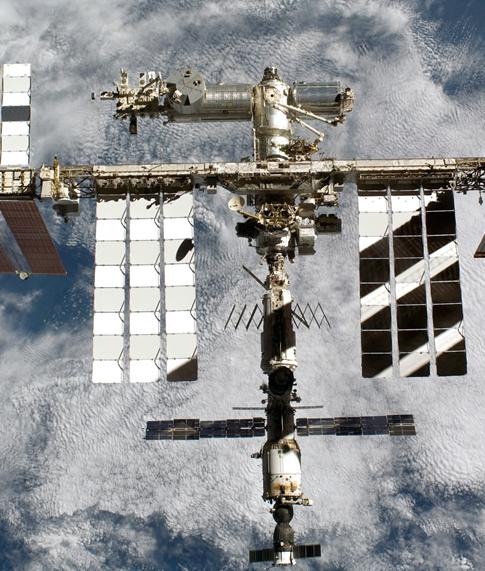
|
Living and Working Onboard the International Space Station |
||||||||
|
|||||||||
 |

Mathematics Skill or Topic Area:
Volumes of Spheres, Cylinders and Cones
Next Gen Science Framework ESS2.C The role of water in Earth’s surface processes; ESS3.B Natural resources; LS2.B Cycles of matter and energy transfer in ecosystems; PS1.A Structure of matter; PS2.C Stability and instability in physical systems; ETS1.A: Defining and Delimiting an Engineering Problem; ETS1.B: Developing Possible Solutions; ETS1.C: Optimizing the Design Solution
Common Core ELA for Science: RST.6-8.2. Determine the central ideas or conclusions of a text; provide an accurate summary of the text distinct from prior knowledge or opinions.RST.6-8.8. Distinguish among facts, reasoned judgment based on research findings, and speculation in a text. RST.6-8.9. Compare and contrast the information gained from experiments, simulations, video, or multimedia sources with that gained from reading a text on the same topic.
Common Core Math Standard: CCSS.8.G.C.9 Know the formulas for the volumes of cones, cylinders, and spheres and use them to solve real-world and mathematical problems.

Video Engagement: Environmental Control on the ISS Learn how engineers turn perspiration into innovation on the International Space Station so astronauts can live and work comfortably. The Environmental Control and Life Support System, or ECLSS, regulates the environment, including temperature, humidity and breathable air. (5 minutes). View Program
|
Engage your students with a press release: Longer, Closer Look at Humans in Space Has Far Reaching Implications
The thought of long-duration space exploration may bring to mind scenes from the 1968 science-fiction movie “2001: A Space Odyssey.” In the film, a giant centrifuge creates artificial gravity and provides Earth-like conditions for crew members—simplifying daily tasks like working, eating and sleeping and allowing the human body to maintain a similar physiological state as it would on the ground.
As thrilling innovations such as this may someday surface in the future, ensuring the health of crew members today is a critical component of long-duration spaceflight. To further the current knowledge base and address the inherent risks, NASA plans to take an inward look at long-term human physiological responses to spaceflight.
NASA and the Russian Federal Space Agency (Roscosmos) recently announced an agreement to send two crew members to the space station on a one-year mission. The other partners in the International Space Station Program also will work to ensure the success of this mission. The valuable scientific data collected will help send humans to new destinations, supporting the next generation of space exploration.
Expected to launch in spring 2015, a Russian Soyuz spacecraft will carry Scott Kelly of NASA and Mikhail Kornienko of Roscosmos to the space station for a one-year stay, the longest space mission ever assigned to a NASA astronaut
“This will build on the rich experience of long-duration flights, including four flights of a year or more conducted by our Russian colleagues on the Mir station,” says Dr. Michael Barratt, program manager for NASA's Human Research Program at the agency's Johnson Space Center in Houston. “We have progressed considerably in our understanding of the human physiology in space and in countermeasures to preserve bone, muscle and fitness since then. The space station program provides us a robust framework for international collaboration that enables us to realize tremendous returns from such an experience.”
Typical physiological responses of long-duration spaceflight include increased bone and muscle loss and decreased cardiovascular function and sensory motor performance. Data from the year-long expedition will provide information about crew performance and health, and aid in the reduction of certain human health risks associated with future exploration.
Press release date line - December 5, 2012 Press release
location: [
Click Here ] |
|
Explore math connections with SpaceMath@NASA
Problem I - The Interior Volume of the Crew Habitation Module - Students use the volume formula for a cylinder, and actual dimensions of the Crew Habitation Module (CHM) to determine the volume available to crew members inside the CHM, allowing for the thickness of the walls. [ Open PDF ]
Problem II -
Spherical Storage Tanks -
Imagine replacing the cylindrical CHMs with a series of spherical habitats linked together.
In this problem, students determine how many spherical habitats must fit together to equal the volume of a cylindrical module with the same
diameter.
[ Open
PDF ]
Explain
your thinking: Write
your own problem - Using information
found in the Math Connection problems, the press release or the video
program, create your own math problem. Explain why you set the problem up this
way, and how you might find its answer.
Evaluate
your understanding: Challenge Problem 1 - The Conical Storage Tanks
A conical tank is often used by astronauts to store and transfer liquids. In this problem, students explore the
volume of a conical storage tank and determine where to put a mark to let astronauts know when the tank is half-full.
[ Open
PDF ]
Challenge Problem 2 - The conical Inflatable Heat Shield
Hypersonic Inflatable Aerodynamic Decelerators (HIAD) are new technology NASA is exploring to create
heat shields that are inflatable, take up less space,
and capable of landing humans and large payloads safely on Earth and Mars. Inflated just before entering the atmosphere, they are conical in shape, and able
to withstand the high temperatures of re-entry.In this problem, students explore the volume and surface areas of various HIAD heat shields.
[ Open
PDF ] [ Open eClips Video ]

NASA / JPL
3-D Solar System
Extend your new knowledge - Science fiction stories often show a space station shaped like a donut - a shape called a torus. Students estimate the total volume of the ISS, and determine the diameter of a donut-shaped space station that has the same volume. [ Open PDF ]